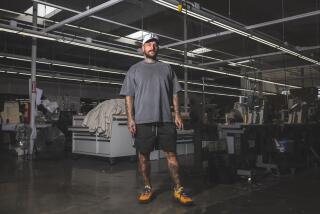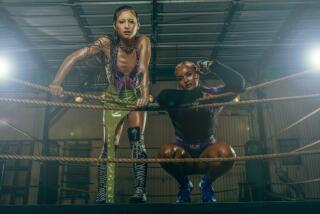Fashion 86 : Men Are Saying the Darnedest Things About Their Socks
- Share via
For many years it was difficult to judge a man’s fashion savvy by what went on inside his shoes. One man’s hosiery (not to mention his hosiery drawer) looked pretty much like another’s. And about the most exciting thing that ever happened to socks was an occasional movie scene in which the hero turned romance to comedy by wearing a pair in bed.
Today it’s a whole new sock game--to the tune of $1.3 billion in retail sales, according to the National Assn. of Hosiery Manufacturers. It’s generated by the Italian-inspired revolution in sportswear, perpetuated by fashion-rich television shows and executed by designers (notably English, French, Japanese, Italian and American) who believe that a man’s socks should be a comfortable, stylish show of individuality.
Despite a cornucopia of argyles, dots, stripes, checks, tweeds, paisleys, plaids, nubby knits, raw silks, Missoni sweater patterns, whimsical geometrics, bright colors and the revolutionary E. G. Smith slouch style--some men still don’t ask much of their socks.
“They’re square guys like my husband,” moans one department store executive. “They just want them to match and stay up. Socks are only something to put in their shoes. If they happen to get two black ones on with a gray suit, they feel well dressed.”
Other men give the accessory more respect. Michael Kassan, an attorney and entertainment-industry executive who owns enough pairs to fill two drawers, equates their importance with that of footwear.
“I never wanted to be the kind of person who wore brown shoes with a tuxedo. To me, that’s the same thing as wearing the wrong color socks. If they’re properly done, they can be an addition to a wardrobe as opposed to being just a neutral fashion tool.”
Both Kassan and real estate executive Steven Gribin often find their wardrobe components at Rick Pallack, a Sherman Oaks establishment that stocks 4,000-5,000 pairs of hosiery in 300 patterns.
Gribin, another two-drawer sock man, explains the store’s convincing system: “They put everything together. They show you a coat, a shirt, a tie and they throw in three pairs of strange socks.”
It’s actually Gribin’s abhorrence of hosiery that makes him opt for something other than standard blue, brown, gray, camel or black: “For the most part I hate socks, which is why I wear the fancier ones. I like the casual look of no socks. So if I have to wear them, they’ve got to be more exciting and accentuate the outfit I’m wearing.”
Argyles are a reliable favorite, but he also owns a sleeper or two, such as a raw silk pair “with tiny gray, black and white stripes. I thought I would never wear them, but they make the suit look that much better.”
No longer a hidden asset--thanks to low vamp shoes and narrow trouser legs--socks have become “probably the most important hot, new fashion item. People are sock crazy,” Pallack claims.
“When men are spending $11 to $23 on a pair of socks, I think they’re doing more than keeping their feet warm,” adds Michael Gilreath, men’s accessories buyer for Bullocks Wilshire. “They’re using them to express a desire to be fashionable or to update a traditional business wardrobe.”
Men have progressed from argyles to “more fun socks” during the past two years, something women generally aren’t aware of, Gilreath says. “Women tend to buy much more conservative styles than a man would for himself.”
At Bullock’s, buyer Terry Payne reports that when the chain opened a Downtown Los Angeles store recently, the No. 1 best seller in men’s hosiery turned out to be “a funky cotton geometric.
“I was amazed, it was so forward. It sold better than any basic sock out of maybe 300 different styles, including solids and cotton athletics. It tells me that the customer is hungry for some unique and different merchandise to wear with a casual wardrobe.”
And at Fred Segal on Melrose Avenue, menswear manager George Grimball claims customers, who spend anywhere from $10 to $24 on imports, “pick out socks the way they would paint or wallpaper. They buy Format, a fabulous Japanese brand, just for the colors. We have another customer who loves Missoni and has us call him any time we get in a shipment. The last time we sent him 24 pairs, and he kept all of them.”
Some men only want cotton socks, others want something all-natural with the staying power of a synthetic. For them, Grimball recommends a French wool-and-cotton combination, which he swears “won’t stretch out at the calf. You could jump off the Empire State Building, and these socks wouldn’t droop.”
One man who does want his hosiery to droop is New Yorker Eric G. Smith, the originator of a slouchy “boot sock.” Made of thick cotton, it comes in more than 30 colors and sells for about $8.50. A tie-dye version at $15 is the company’s “benefit sock. It has ‘60’s sensibilities,” says Smith, who donates all the money from sales to various AIDS charities.”
An attorney turned fashion guru, Smith is credited by retailers like Don Zuidema, owner of Los Angeles Sporting Club, for “filling a niche between the basic gym sock and the dress sock.”
Those happy to have fallen into the niche include Whoopi Goldberg, who Smith says whipped off her boots the last time he saw her in Los Angeles to show him she was wearing a white pair. And when a New York specialty store was robbed recently, Smith says only his socks were taken.
Along with Smith there are other mavericks in the industry. Michael Speyer, the 38-year-old president of San Diego’s Mountain High Knitting Mills, says his is the only mill west of the Mississippi “that makes anything other than tube socks.”
As the producer of designer hosiery for a secret list of manufacturers, Speyer says he successfully competes “with the Japanese, French, English and Italians” by using Japanese and Italian computerized kitting machines.
Both computerized knitting and specialization have given the industry two record years with about 70 million dozen pairs shipped in 1984 and again in 1985. Among all those socks are everything from ‘50s-inspired whites and Christian Dior’s fanciful palm trees to sports models by Thor-lo that have carefully designed padding based on whether men (or women) are using their feet for basketball, aerobics, golf, tennis, running, hiking or skiing.
While “Miami Vice’s” Don Johnson is credited with encouraging men to take off their socks (and designer Bill Blass years earlier), Perry Ellis, Calvin Klein, Jhane Barnes, Ralph Lauren and Alexander Julian are credited with convincing men to keep them on. Just how they should be worn--if at all--has a lot to do with personal taste--and a few rules supplied by retailer Pallack.
A no-socks man in the summertime, Pallack counsels that a woven slip-on or an espadrille is proper sockless etiquette. White socks can be “very tasty” with jeans, cotton pants or “a high-fashion sporty outfit, if a man knows what he is doing.”
The right way to store hosiery is folded in a drawer. Silk, cashmere, fine wool or fine cotton socks require hand-laundering and towel-drying. Lightweight, over-the-calf socks are de rigueur with a business suit or a tuxedo .
“When a man crosses his leg, you should never see his bare skin,” Pallack explains. “It’s not a flattering sight no matter how nice his calves are.”
For more casual attire, “to the calf is fine,” and for someone who wants to rock the sock boat, Pallack suggests wearing two compatible patterns: “If both socks are the same color, people won’t think you did it by accident, and unless they look closely they won’t be able to notice the difference. Of course, it can tell you how observant they are.”






